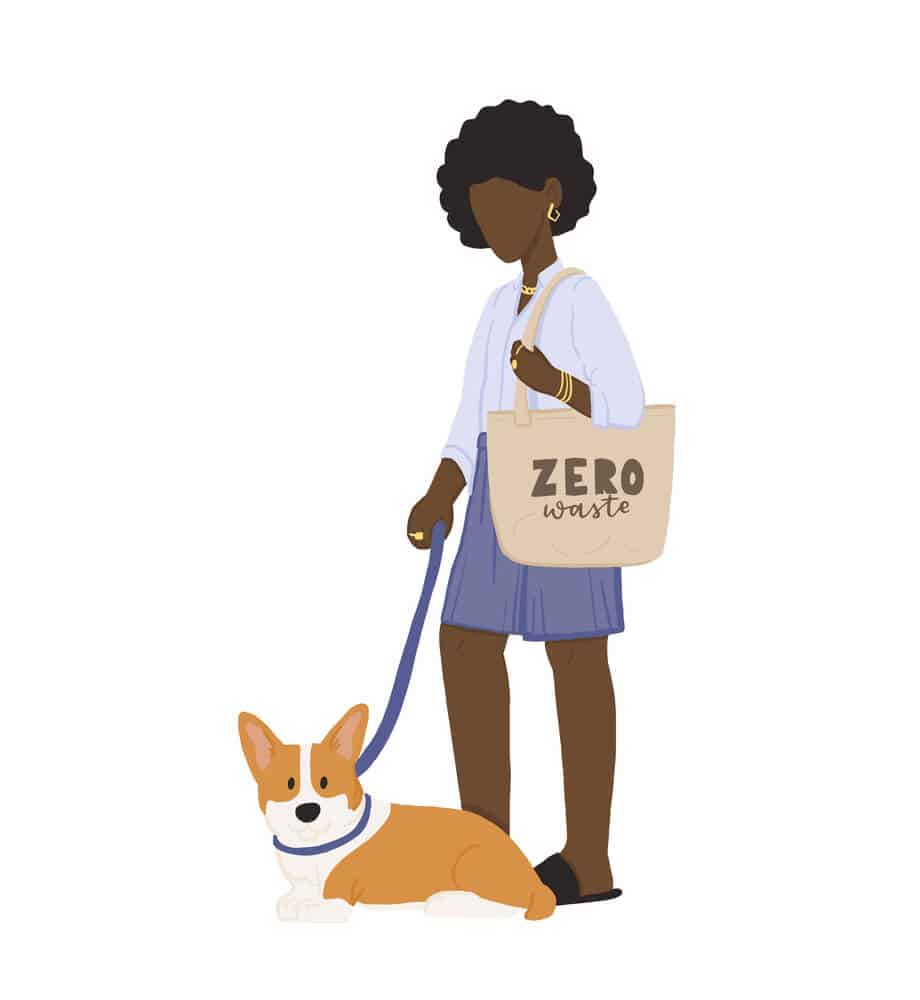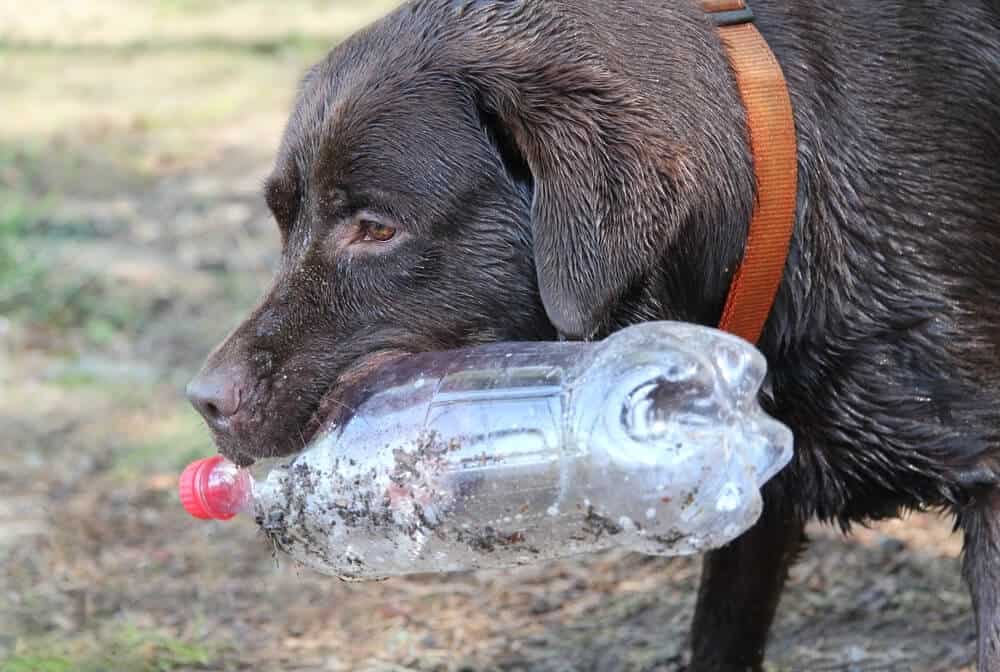How to go zero waste with a dog is probably something you’ve spent a good few hours considering if you’re planet-conscious and you also have a four-legged friend.
Dogs (and most other pets) generate a lot of waste, and it can be tricky to stomach that if you’re an animal lover who wants the best for the planet.
When going zero waste with a dog, try to think about what generates the most waste.
Food is probably a big one, so that recyclable packaging will be a must. Other waste could include treats, poop disposal, potty training, and possibly even chew toys.
There are lots of ways to make all these things eco-friendly.
Zero Waste Dog Food
A study done by UCLA and explored by NewsRoom shows that the meat eaten by cats and dogs could equate to 64 million tons of carbon dioxide every single year.
They are responsible for up to 30 percent of meat consumption in the USA, and that percentage is likely to increase as more humans move toward vegetarianism or veganism.
However, we’re not recommending that you put your pets on a vegan diet, especially not cats.
While dogs can eat plenty of vegetables, your pet’s health must come first, and most dogs do want at least some meat in their diets.
However, there are things you can do to make your dog’s food a little less heavy on the environment.
- Buy meat in cans. Cans are recyclable, reasonably lightweight, and won’t break while being transported, meaning they are a low waste option for packaging food.
- Don’t just grab “human grade” on the assumption that it will be better. According to SustainableJungle, this increases meat production (as humans also want these prime cuts so more animals are needed and more meat may be wasted) without actually benefiting your pooch.
- Explore vegetarian or vegan options in conjunction with your veterinarian. It is thought that dogs can be perfectly healthy on a vegan diet, as long as this is done properly. Make knowledgeable choices that will keep your dog healthy while being planet-conscious.
- Find bulk options; more giant bags equal less plastic overall.
- Remember that some animal choices (such as chicken) have a lower carbon footprint than others (such as beef).
- If you have time, consider making some or all of their food from scratch, provided you have a solid understanding of animal nutrition, and you have discussed this with your veterinarian. This is a great way to reduce waste as you may be able to source ingredients packaging free.
- Look into a raw food diet; some dog owners find this works for them, and many of the companies have options for returning or recycling packaging.
Where possible, we buy tinned food as we haven’t got time to make our own.
Kibble is bought in large bags or cardboard boxes, and waste is minimized.
Food packaging that can’t go in our general recycling is washed and shipped to a firm specializing in recycling foil packets.
Recycling isn’t the perfect answer, but we do our best to reduce the impact of pet ownership!
Zero Waste Dog Treats
Dog treats are much easier to “zero waste” than food. You may find your local pet store sells them packaging-free, and there are lots of options for making your own treats at home.
A treat could also be a little bit of whatever you’re having for supper, provided it’s safe for your pup.
Avoid treats in plastic packaging and take your own bag if buying loose treats, and you should find this an area where it’s easy to reduce your waste.

Zero Waste Poop Disposal
This is a big one for many dog owners, and there isn’t really an easy solution.
TheVerge states that cats and dogs produce 30 percent as much poop as Americans, and KeepNatureWild tells us that it can cause environmental problems by polluting water or harming wildlife.
It’s a pretty difficult one to deal with.
While it’s generally agreed that the most environmental thing to do is to pick up the waste, that leads to millions of plastic bags full of dog poop in landfill sites.
However, you can buy compostable bags and unique composting systems that will help safely break down your dog waste.
While compostable bags won’t disappear in landfill sites because the conditions aren’t right, they are at least less plastic, and if the waste is incinerated, they are better for the planet.
You can, of course, compost dog poop yourself, but you should never put it in your regular compost bin.
The parasites and bacteria in it could be dangerous to you if you then use this compost to grow vegetables or other food.
Compost containing dog waste is only suitable for non-edible gardening – but if you can keep it separate or you don’t grow your own food, composting it at home is the environmental option out there.
Zero Waste Potty Training
If you’ve got a young pup and you’re wondering how to train it without those plastic puppy pads… well, there are a few choices.
First and foremost is the option of always getting your dog outside to toilet.
Some experts recommend this as it is the less confusing option for the dog, but you may still want some protection for your floors while your pup is learning.
A couple of options include:
- Newspapers
- Old towels
- Washable waterproof mats
- A waterproof mattress cover
You may also want to use some plastic sheeting underneath to ensure any liquid doesn’t soak through for the first two options.
This plastic can then be rinsed off and reused.
Zero Waste Toys
Aside from the practical aspects of dog ownership, what about toys?
If your dog is a destroyer, you may have a collection of wrecked toys that you don’t know what to do with.
You can rarely source dog toys second-hand, so how do you help your pup have fun while minimizing waste?
The best thing you can do is choose toys that are eco-friendly themselves, that will break down naturally when they are finished with.
Bamboo toys are a good option, or – for stuffed toys – ones that are cotton or hemp, with natural fibers inside.
For chew toys, consider edible ones such as bones, which can be composted when your dog has had its fun.
Alternatively, get hemp ropes or choose toys famous for their durability, like Kongs. All-natural rubber is the best choice.
The great thing about these eco toys is that as well as helping the planet, you can feel comfortable knowing your dog is not swallowing plastic fibers or ingesting chemicals from their toy.
When these things reach the end of their life, you can toss them on the compost pile and they will disappear.
Summary
Zero wastings with a dog present some challenges, as much of their food is packaged in plastic, their waste is often wrapped in plastic, and their toys are usually – yes, plastic.
However, it can be done!
Choose consciously and think about the hidden costs of food (e.g., choosing low-impact meats such as chicken and aiming for “waste” meats where possible) and other areas.
Production and disposal are as important as use, and if you consider all those areas, you can rest assured that you’re doing your best for the planet.


